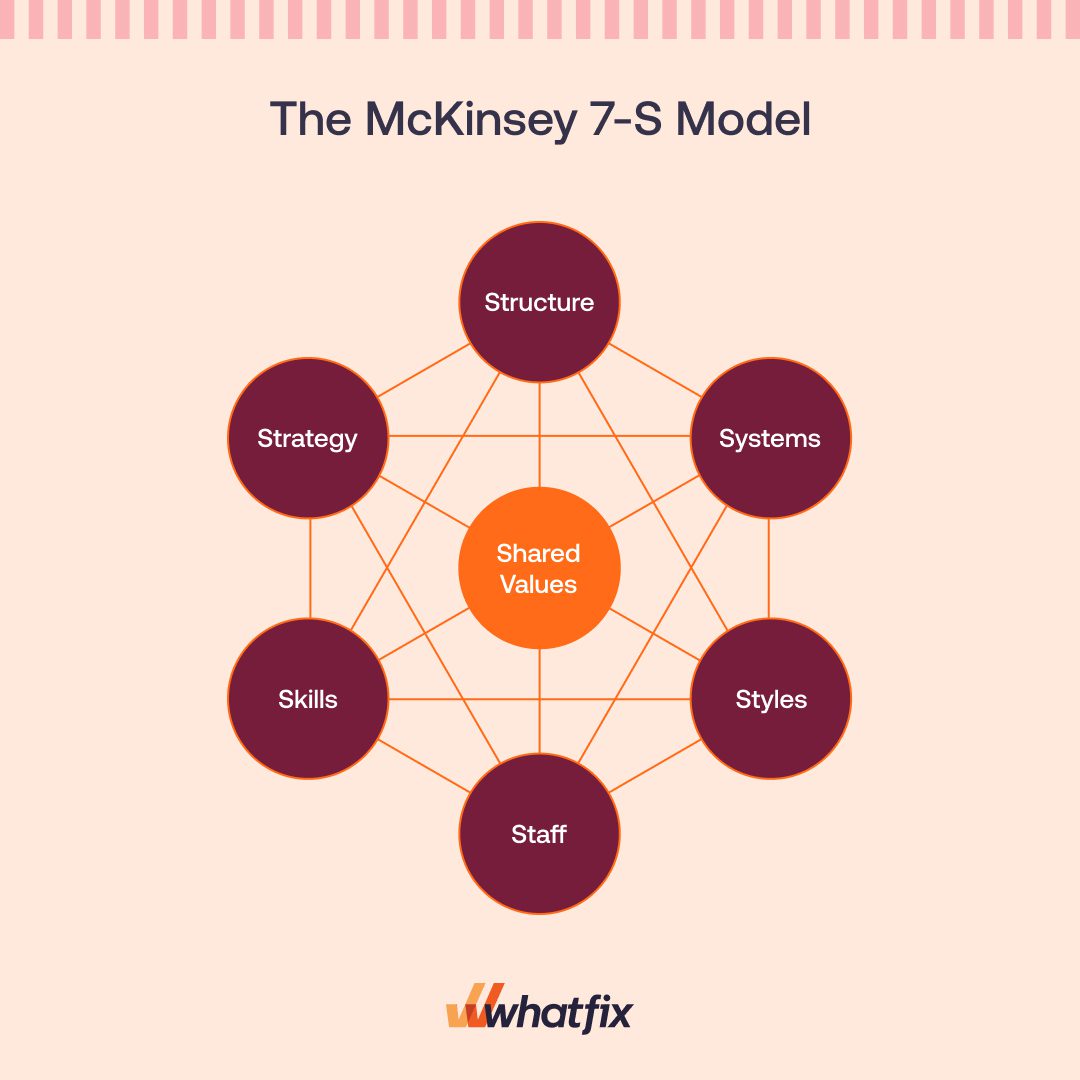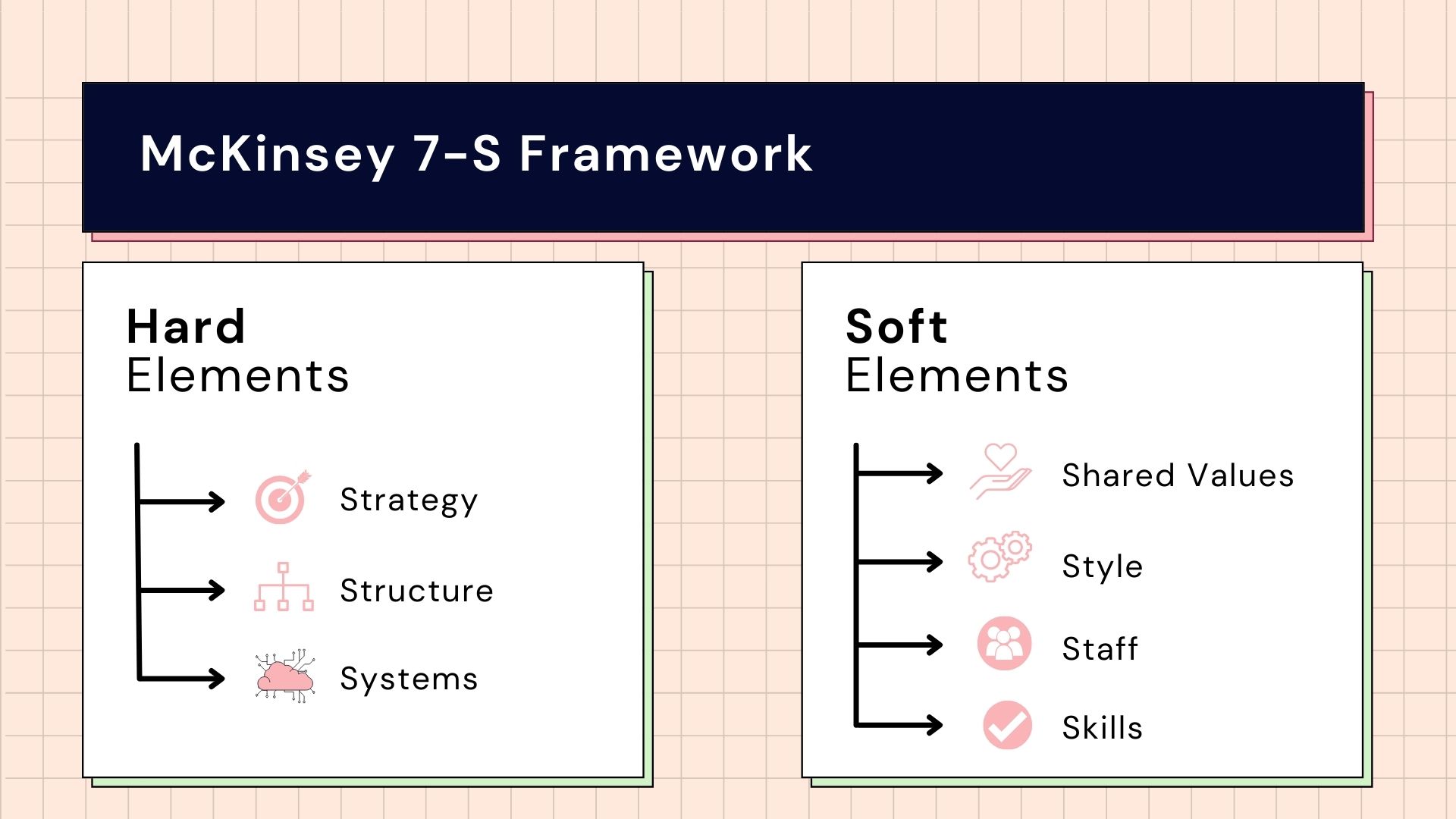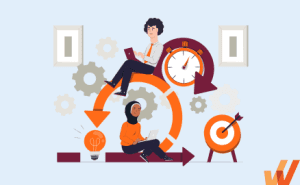McKinsey’s 7-S Framework was first introduced in the 1970s by business consultants Robert Waterman and Tom Peters in the book In Search of Excellence, who examined the role of coordination in organizational effectiveness. Previous models to this point had focused on organizational structure as the focal point when considering enterprise effectiveness.
The framework mapped the intersectionality of seven factors that influence an organization’s ability to adapt and change. It highlighted the interdependence of these factors and that without working on these seven factors in a coordinate way, no single factor would experience improvements.
Today, McKinsey’s 7-S Model is a widely used change management model. Organizations use it to assess potential change and monitor its impact on internal operations.
In this article, we explore in-depth the critical elements of McKinsey’s 7-S Model, its implementation, and how enterprise organizations have leveraged this model for effective change management.
What Is the McKinsey 7-S Model?
The McKinsey 7-S Model is a change framework based on a company’s organizational design and coordination. It aims to depict how to manage organizational change by strategizing around the interactions of seven key elements: Structure, Strategy, System, Shared Values, Skill, Style, and Staff.
The 7-S model highlights that there exists a domino effect when any one element is transformed to restore effective balance. The central placement of shared values emphasizes that a substantial change culture impacts all the other elements to drive change.

The Elements of the McKinsey 7-S Framework
The McKinsey 7-S Model depicts seven shared values: Structure, Strategy, System, Shared Values, Skill, Style, and Staff.
The McKinsey 7-S Framework then categorizes these seven elements into two categories: hard elements and soft elements.
- Hard ‘S’ elements are easily identifiable and influenced by leadership and management. They include Strategy, Structure, and Systems.
- Soft ‘S’ elements are those that are intangible and culture-driven. They include Shared Values, Style, Staff, and Skills.

Let’s explain each ‘S’ element of the McKinsey 7-S Model in more detail.
1. Strategy
The strategy element is a detailed plan that organizations create for successful change implementation and to gain a competitive edge. A well-crafted strategy is aligned with the other six elements of the 7-S model and is reinforced by a strong vision, mission, and values.
2. Structure
Structure or organizational structure refers to a clear chain of command to avoid chaos & confusion. Structure is a simple yet crucial element as it creates a sense of employee accountability within the organization.
3. Systems
Systems refer to the processes and operational procedures employed to complete a business’s routine activities. An organization’s SOPs comprise practices and workflows that directly impact productivity and decision-making.
4. Shared Values
These are the core values governing an organization’s health. While implementing a change, organizations expect a behavioral modification from their employees, which is only possible in a strong change culture and organizational values.
5. Style
This element refers to the management style prevalent in a company that decides the level of employee productivity and satisfaction.
6. Staff
This element represents the talent pool required, the size of the existing workforce, and their motivations. It also considers how they are trained and rewarded within the organization.
7. Skills
Skills refer to the abilities of employees to complete tasks. A study suggests that 45% of respondents reported that a skill gap caused a loss in productivity. Skills gaps overburden experienced employees who have to pick up the slack for their coworkers’ inexperience. It’s essential to identify the skill gaps and create relevant employee training programs to bridge these gaps.
McKinsey 7-S Model Worksheet Template
✓ Thank you, the checklist will be sent to your email
How to Implement McKinsey’s 7-S Model
Change agents can effectively implement the McKinsey 7-S model using a top-bottom approach.
You must identify which elements of the 7-S framework to realign to improve organizational performance or maintain alignment and performance during other changes such as restructuring, process improvement, a corporate merger, new software implementation, or a leadership change.
Here are the following action items to consider before applying the 7-S model:
1. Identify the Gaps and Unaligned Processes
Perform a business process analysis to identify gaps and inconsistencies in your organization’s existing business processes. List the unaligned areas and what needs to change to restore the effective balance.
2. Determine the Ideal Organizational Design
This step is research-intensive and requires change leaders to find the sweet spot where management’s vision of an optimal organizational design aligns well with the sentiments of the rest of the team members.
3. Create an Effective Action Plan
After identifying the outliers, change agents must create a detailed implementation plan. The action plan should include required changes to the organization’s hierarchy, communication flow, and reporting relationships, which will allow the company to achieve the desired organizational design.
4. Implement the Change
The change implementation stage is the most critical stage of any change initiative, and only well-implemented changes will avoid resistance to change and prevent overall change failures. You should identify internal change agents or hire change consultants best suited to implement your changes.
5. Maintain the Momentum with Continuous Review Processes
These seven elements are highly dynamic and change constantly. Therefore, practitioners must track these elements and their impact on one another to maintain the momentum of change.
Related Resources
Example of the McKinsey 7s Model in Action
Studying corporate examples of how they tackle organizational changes based on the 7-S model reveals the practical applications of this model, including both the failure and success of organizational change projects.
To understand the interconnectedness of McKinsey’s 7-S Framework, let’s explore McDonald’s as a case study:
McDonald’s 7-S Framework Example
| Strategy | McDonald’s overall business strategy includes two pillars: its franchise-based business model and its Velocity Growth Plan. 90% of US-based McDonald’s locations are locally owned franchises, meaning the restaurants are owned and operated by local business people in the community. This offsets costs for McDonald’s, provides opportunities in thousands of communities, and enables the company to have an integrated voice in every community. Each location can operate its store as it sees best, from menu offerings to business management styles and community involvement.
Its Velocity Growth Strategy focuses on retaining its customers by fortifying its focus on what it does best (breakfast, low prices), regaining lost customers by refocusing on quality and converting customers from other chains to loyal McDonald’s customers by entering new markets and offering new product lines (like coffee and desserts). |
| Style | McDonald’s leverages a participative leadership style where seniors engage with employees at different levels to seek feedback to improve operations and resolve conflicts. Its franchise model allows individual store owners to operate their stores based on the local conditions and strengths. This also provides a direct line of communication with the local community by advocating from within. |
| Staff | With over 210,000 employees, McDonald’s is one of the largest employers in the world. It believes in diversity and strives for employee satisfaction. It provides upskilling and managerial mobility for all entry-level employees and provides opportunities that other restaurant chains lack. |
| Skills | McDonald’s trains its employees to provide an unparalleled customer experience and handle objections. It recently allocated $150M to its Archways to Opportunity education program, which offers 400,000 employees with a path to obtaining their high school diploma or GED, upfront college tuition assistance, free tutoring services, and ESL services for non-English speakers.
It also provides its franchises with corporate onboarding, training, and upskilling courses and materials to enable their workforce across locations. Its employee training is provided in various learning formats, from online PDFs, videos, and traditional in-person training. |
| Shared Values | McDonald’s aims to have high integrity, serve a wide range of customers, hire employees from different backgrounds, encourage teamwork, and give profits back to the community with its core values: Serve, Inclusion, Integrity, Community, and Family.
Its franchise model allows it to have a presence in local communities and support what makes the most significant impact across its 14,000 US-based stores. McDonald’s offers a variety of community-based programs and non-profit entities, including its Ronald McDonald House, HACER National Scholarships, Black & Positively Golden program, its manager training programs, and more. McDonald’s also shares its values in how it operates through pledges to source from only renewable, recycled, and certified sources. |
| Structure | Unlike other multinational restaurant corporations with complex hierarchical structures, McDonald’s has a flat structure where a store manager manages its employees. Employees work as a close-knit team and have easy access to senior management if necessary. Its franchise model enables each store to operate independently, depending on the skill sets of its owners and team members. This enables McDonalds to operate anywhere and utilize the talents of the people and culture in each community. |
| Systems | McDonald’s is known for constantly innovating to drive core business outcomes, like reducing wait times (via self-ordering kiosks), providing better customer experiences (via its McDonald’s app), and improving product and supply chain efficiency (through automation and AI).
In 2019, McDonald’s acquired Dynamic Yield, an AI company that focused on ML decision logic and personalization, for $300M. The company is actively using this AI technology to optimize the efficiency of its drive-thru experience and reduce customer wait times. In 2023, McDonald’s partnered with Whatfix to drive the adoption of its custom application, which franchises and owner-operators use to configure and customize their menu items. McDonald’s realized its unique structure required more staff support on the systems that enable its over 8,000 locally owned franchised locations. With Whatfix, McDonald’s enabled owner-operators with in-app guidance on its custom ‘Restaurant File Management’ system to support users on menu tasks like adding new items, activating promotional items, changing the hours of availability, and setting prices. This drove business outcomes by enabling its staff with support in the flow of work to utilize systems properly. The downstream impact improved activations of seasonal menu items that drove revenue, improved marketing ROI by providing customers with season items promised in advertising, and improved owner-operated efficiency by reducing the need for IT support when menu-related issues occurred. |
How McKinsey’s 7-S Framework Drives Digital Transformation Success
McKinsey’s seven elements (Structure, Strategy, Shared Values, Skill, System, Shared Values, Style, and Staff) are highly interconnected. If change leaders fail to create a well-rounded action plan to restore the balance, a company will fail to adapt to changes in its environment.
The past decade has experienced an incredible workplace shift from traditional processes and manual systems to integrated systems and the digital workplace. Through digital transformation, organizations are empowered to maximize their efficiency, make data-driven decisions, provide superior customer experiences, and achieve previous unobtainable levels of growth.
As McKinsey’s 7-S Framework proposed, transformational change projects will likely fail unless organizations address the impact new digital technologies have across its seven key elements. Technology must be built with these organizational factors in mind.
McKinsey’s 7-S Framework for Digital Transformation
| Strategy | Strategy provides a foundation for all decisions. Organizations must build an overarching corporate strategy to inform and dictate their digital strategy. Digital transformation initiatives and new technology must address current business friction points and align with business goals. This foundational strategy underscores the success of any digital transformation change project and is why strategy is the first ‘S’ in McKinsey’s 7-S Framework. |
| Style | Styles refers to the overall management style – whether that is a top-down command chain or a more decentralized company structure. Regardless of style, leaders must advocate for digital change and embrace new technologies by becoming early adopters to lead by example. |
| Staff | Staff refers to having the right people in key positions to ensure the success of the digital transformation. This may mean hiring experienced digital leaders to orchestrate change and build high-level strategy, hiring staff who will be responsible for digital services (like IT support, software design, application implementation, and usage monitoring), and hiring the right end-user employees. |
| Skills | Skills refers to ensuring your workforce possesses the skill sets to facilitate and adopt a new digital application – across the transformation team, the change team, and application end-users. This requires conducting skill gap assessments, providing digital upskilling, and enabling employees with the support they need in the flow of work to maximize the use of digital investments. |
| Shared Values | Shared values refer to company culture in relation to change projects. Organizations must embrace change as a core tenet of their value proposition by hiring the right talent and enabling them with adaptability and change management training. This allows employees to embrace change by empowering them with the skills to realize the benefits of new systems by taking a practice approach to adoption. |
| Structure | The structure is closely related to style and staff. While enterprises typically have hybrid-decentralized structures, organizations must have IT governance frameworks in place to drive value from mission-critical applications. For example, if different departments or regional offices use fractured applications, data becomes siloed, employees resist change, software budgets become bloated, employees cannot transfer between departments, etc. Organizations also must consider roles and responsibilities for owning digital strategy and how to build a cross-departmental team that considers business processes, digital strategy, and technology infrastructure all related to a company’s business goals and outcomes. |
| Systems | Systems is the final ‘S’ in McKinsey’s 7-S Framework. While systems are typically the focal point of digital transformation, we’ve intentionally set this as the point to cover. Systems should be viewed as the outcome of a digital transformation initiative, ie. its overall success. Systems alone will not achieve digital transformation or drive business outcomes. And that’s the point of McKinsey’s 7-S Model. Organizations must prioritize its staff, skills, strategy, style, shard values, and structure when implementing new systems. This enables digital transformation projects to be contextually designed to meet the needs of a company’s people, processes, and business outcomes. |
Explore other popular change management models:
Change Clicks Better With Whatfix
To drive change adoption and maximize value realization from digital transformation investments, organizations must train and support employees through times of change and enable them with user-friendly technology experiences that work for them. That’s why software clicks better with Whatfix.
With Whatfix Mirror, L&D teams and change leaders easily create replicate sandbox application environments of your enterprise applications and tasks to provide interactive, hands-on application training in a risk-free sandbox.

Whatfix DAP is a digital adoption platform that provides organizations with a no-code editor to create in-app guidance and support in the flow of work to help employees quickly become familiar with new technologies and adopt new processes. With Whatfix DAP, accelerate new hire time-to-proficiency or drive change adoption with Task Lists and Tours. Flows provide in-app guidance for complex workflows, and Smart Tips help employees through infrequently done tasks. Self Help integrates with your knowledge repositories, helping users find answers to support questions and process-related help easily.

With Whatfix Product Analytics, set up custom events to track user behavior, benchmark key user adoption KPIs (like time-to-proficiency, funnel conversion, time-to-completion, etc.), analyze workflows, and identify areas of user friction. Use these insights to create a data-driven, continuous improvement approach to building frictionless business processes and tasks that work for your end-users.
Ready to get started? Request a Whatfix demo!






